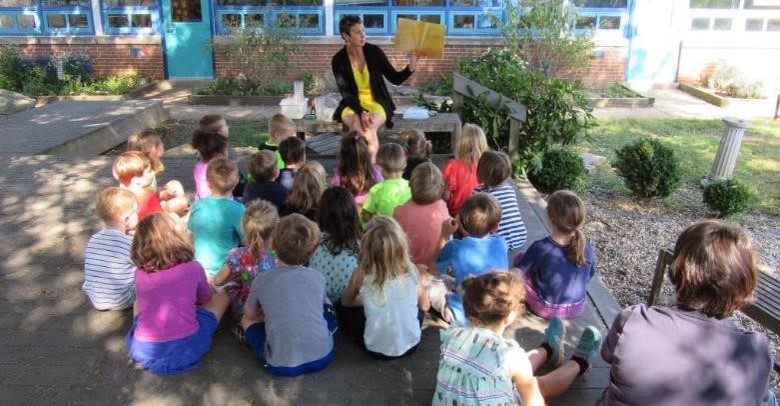Environmental Teaching in the Classroom
As part of the Arlington Public Schools' program of studies, students develop an understanding of how humans affect the ecosystems in a variety of ways.
As part of the Arlington Public Schools' program of studies, students develop an understanding of how humans affect the ecosystems in a variety of ways.

“All education is environmental education. By what is included or excluded, students are taught that they are part of or apart from the natural world.”
David W. Orr, Earth in Mind, 1994
The Social Studies Department provides instruction on environment issues. Students develop fundamental understanding of society’s interplay with the natural environment on local, regional and global scales through the study of concepts related to physical, economic, cultural, urban, political, historical and environmental geography. Examples of such study include activities on global warming, the polar regions, recycling, energy consumption, nuclear dump sites, degradations of the Rainforests, “Green” initiatives, pollution in China, India’s “Green Revolution”, etc.A variety of resources are used to teach environmental related issues including field trips, newspapers/magazines, National Geographic issues, film (The Day After Tomorrow), National Public Radio reports on climate, demographic data, CNN series on Planet in Peril, etc.
The student will investigate and understand that materials can be reused, recycled, and conserved. Key concepts include
The student will investigate and understand that natural resources are limited. Key concepts include
The student will investigate and understand that plants produce oxygen and food, are a source of useful products, and provide benefits in nature. Key concepts include
The student will investigate and understand that natural events and human influences can affect the survival of species. Key concepts include
The student will investigate and understand different sources of energy. Key concepts include
The student will investigate and understand important Virginia natural resources. Key concepts include
The student will investigate and understand public policy decisions relating to the environment. Key concepts include
In addition to the “Resource” strand, the Science Standards of Learning for the elementary grades contain the following standards:
The student will investigate and understand that living things are part of a system. Key concepts include
The student will investigate and understand that weather and seasonal changes affect plants, animals, and their surroundings. Key concepts include
The student will investigate and understand that environments support a diversity of plants and animals that share limited resources. Key concepts include
The student will investigate and understand the major components of soil, its origin, and importance to plants and animals including humans. Key concepts include
The student will investigate and understand the water cycle and its relationship to life on Earth. Key concepts include
The student will investigate and understand how plants and animals in an ecosystem interact with one another and the nonliving environment. Key concepts include
The student will investigate and understand characteristics of the ocean environment. Key concepts include
The student will investigate and understand how the Earth’s surface is constantly changing. Key concepts include
There are many Science Standards at the secondary level that directly apply to environmental concerns. They include, but are not limited to, the following:
Also at the secondary level are courses in Advanced Placement Biology and International Baccalaureate Biology. Additionally, students may enroll in Advanced Placement Environmental Science, a college level course designed to provide students with scientific principles, concepts and methodologies required to understand the interrelationships of the natural world, to identify and analyze environmental problems both natural and human-made, to evaluate the relative risks associated with these problems, and to examine alternative solutions for resolving and/or preventing them. Or students may enroll in International Baccalaureate Environmental Systems, a rigorous study of environmental issues and problems caused by our use of the natural world.
Part of the Arlington Public Schools’ curriculum is student visits to Phoebe Hall Knipling Outdoor Laboratory located in Fauquier County near Gainesville, Virginia. This 210 acre tract of land is owned by the Arlington Outdoor Education Association and made available to the school system as an outdoor science laboratory. Student groups are scheduled for day or overnight visits for specific learning activities. Programs conducted at the laboratory are related to the K-12 science curriculum as well as other curriculum areas. Students learn to observe in this natural environment, generalize about the interrelationships within the environment, and develop environmental awareness. Students learn how their decisions and behavior affect other living things. As they acquire knowledge and understanding from and about the environment, students develop competence in evaluating alternatives for using and managing resources. Approximately 9,000 Arlington Public School students visit the Outdoor Lab each year.
Additional information about the Arlington Outdoor Education Association is available at: www.outdoorlab.org
Grade 6 and Grade 7 students participate in Earth Force, a program that engages young people as active citizens who improve the environment and their communities now and in the future. Earth Force educators are provided a variety of professional development materials, training and support for the GREEN program. This program includes the Protecting Our Watersheds curriculum, Virginia Waterways, a guide to activities covering watersheds, water monitoring and land use in the Chesapeake Bay Watershed, training to ensure participants are comfortable with the curriculum and have the necessary skills to facilitate a successful project, network of continuing support, and water monitoring equipment to include water quality test kits. More information on Earth Force is available at: http://earthforce.org/